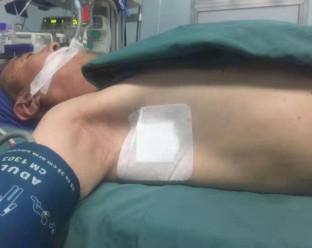Journal of Clinical Monitoring and Computing ( IF 2.0 ) Pub Date : 2022-07-05 , DOI: 10.1007/s10877-022-00892-4 Yanran Dai 1 , Mengjia Luo 1 , Feifei Liu 1 , Xiangying Feng 1 , Huang Nie 2

|
Objective
To investigate whether the temperature recorded by an iThermonitor has better concordance with the core temperature than the bladder temperature recorded by a Foley catheter sensor in laparoscopic rectal surgery.
Methods
Eighty-two adults undergoing laparoscopic rectal surgery were enrolled. Temperatures were continuously measured by a distal oesophageal probe (the reference core temperature), axillary iThermonitor and Foley catheter sensor (bladder temperature) in each patient during surgery. Pairs of axillary and core temperatures or pairs of bladder temperature and core temperatures were compared and summarized using linear regression and the repeated-measured Bland–Altman method during the whole surgical period and pneumoperitoneum period.
Results
There were 3303 pairs of temperature measurements during the whole surgical period. The mean difference between iThermonitor and oesophageal was 0.05 °C ; the limits of agreement were − 0.48 to 0.56 °C. The mean difference between the oesophagus and bladder was 0.28 °C; the limits of agreement were − 0.39 to 0.94 °C (P < 0.001, F-test vs. iThermonitor). Ninety -five% of all iThermonitor values were within 0.5 °C of oesophageal temperature, whereas the proportion for oesophageal and bladder differences within 0.5 °C was only 84% (95% confidence interval 80–88%). Lin’s CCC for the iThermonitor and bladder measurements were 0.842 (95%CI: 0.831–0.851) and 0.688 (95%CI: 0.673–0.703) respectively. Similar results were found during the pneumoperitoneum period.
Conclusions
The temperature recorded by iThermonitor has better concordance with the core temperature than the bladder temperature recorded by Foley catheter sensor in laparoscopic rectal surgery.
中文翻译:

可穿戴无线腋窝传感器 iThermonitor 而非膀胱探头的温度测量代表腹腔镜直肠手术期间的核心温度
客观的
调查在腹腔镜直肠手术中,iThermonitor 记录的温度与核心温度的一致性是否优于 Foley 导管传感器记录的膀胱温度。
方法
82 名接受腹腔镜直肠手术的成年人被纳入研究。在手术期间,通过远端食管探针(参考核心温度)、腋窝 iThermonitor 和 Foley 导管传感器(膀胱温度)连续测量温度。在整个手术期间和气腹期间,使用线性回归和重复测量的 Bland-Altman 方法比较和总结成对的腋窝和核心温度或成对的膀胱温度和核心温度。
结果
整个手术期间共有3303对体温测量。iThermonitor 和食管之间的平均差异为 0.05 °C;协议限度为 - 0.48 至 0.56 °C。食管和膀胱的平均温差为 0.28 °C;一致限度为 - 0.39 至 0.94 °C(P < 0.001,F 检验与 iThermonitor)。所有 iThermonitor 值的 95% 在食道温度的 0.5 °C 以内,而食道和膀胱温度在 0.5 °C 以内的差异比例仅为 84%(95% 置信区间 80-88%)。Lin 的 iThermonitor 和膀胱测量值的 CCC 分别为 0.842 (95%CI: 0.831–0.851) 和 0.688 (95%CI: 0.673–0.703)。在气腹期间也发现了类似的结果。
结论
在腹腔镜直肠手术中,iThermonitor 记录的温度与核心温度的一致性优于 Foley 导管传感器记录的膀胱温度。











































 京公网安备 11010802027423号
京公网安备 11010802027423号